|
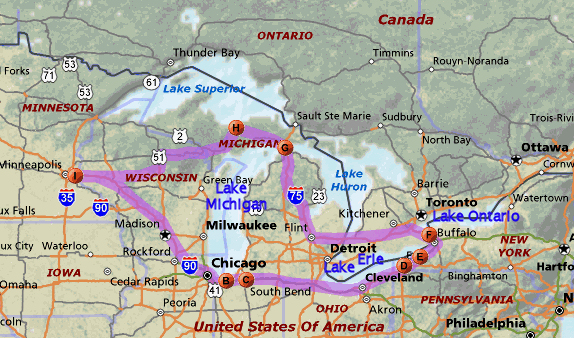

|
Sunday July 28, 2007.
D - Erie, Pennsylvania.
We drove from South Bend, Indiana to Erie, Pennsylvania. We arrived to find that
the "Discover Presque Isle 2007" event at Presque Isle State Park was in full swing.
|
|
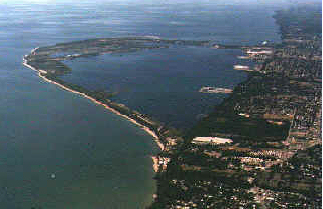
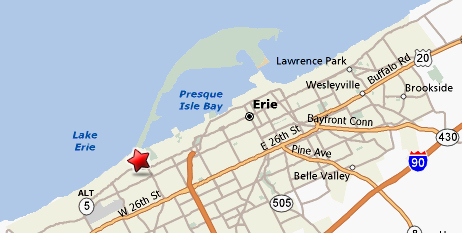
|
|
Presque Isle, located near Erie, Pennsylvania, is a recurving sand spit jutting into Lake
Erie and has the only surf beach
in the state.
The neck of the peninsula is attached to the mainland four miles west of downtown
Erie. The park creates Presque Isle Bay, a wide and deep harbor for the city of
Erie. The bay attracts many pleasure boats and worldwide freighters, making Erie
an important Great Lakes shipping port. Commodore Oliver Hazard Perry, along with
Presque Isle, played a vital role in the victory over the British in the War of 1812.
The famous quotation "We have met the enemy and they are ours," was made by Perry
during the Battle of Lake Erie in the War of 1812, which secured the south shore of the
lake for the U.S.
Perry strategically used the peninsula’s bay as a natural protection for his men,
and a place to construct 6 of the 9 ships in his fleet.
Presque Isle State Park is a 3,200-acre sandy peninsula that arches into Lake Erie.
As Pennsylvania's only "seashore," Presque Isle offers its visitors a beautiful
coastline and many recreational activities, including swimming, boating, fishing,
hiking, bicycling and in-line skating.
|
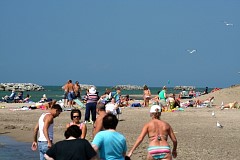
We walked out on one of the beaches to see the view.
|
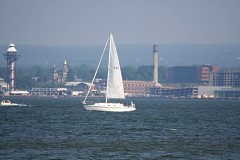
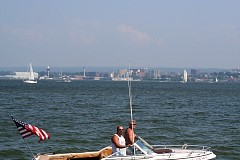
Here is the view from Presque Isle across Presque Isle Bay toward downtown Erie.
|
|
While we were in Erie we stopped by the William Maxwell Wood house. The staff
kindly made a copy of this magazine article for us.
From Erie and Chautauqua Magazine
"When I was in law school," Attorney George M. Schroeck remembers, "someone wrote
that law school is a place where old men in their 20s go to die. If that's true, at.
least some of us got to choose our mausoleums."
Schroeck's site of entombment couldn't
be better appointed or more suitable to his practice as a personal injury and environmental
lawyer. The Wood-Morrison House, at 338 West Sixth Street, is an Erie landmark, built in
the 1850s for Dr. William Maxwell Wood; at that time it was the only house on the north
side of Sixth Street between Myrtle and Chestnut. An Italianate brick two-story with
pyramidal roof and a ship house cupola, it boasts of elegant hardwood floors, nine
fireplaces, and 12 rooms, all of which are used to house the law office of Schroeck
and Segel, P.C.
The history of the house's ownership is as interesting as the building itself. Dr.
Wood had been a key figure in the acquisition of California by the United States in
dangerous secret missions between the U.S. and Mexico. He came to Erie from Baltimore
in 1847 to serve as surgeon of the USS Michigan, later known as the USS Wolverine,
the first iron-clad warship in the world. In addition to being credited with saving
the life of President Zachary Taylor, who fell ill while visiting Erie during August
of 1849, Dr. Wood is noteworthy as the first surgeon general of the U.S. Navy,
appointed to the post in 1869. The physician was also a successful writer, the author
of several travel books and articles about Erie.
Dr. Wood's son, Charles Erskine Scott Wood, was born in Erie and raised in the Sixth
Street house. Military officer, lawyer, and poet, Erskine also proved an able writer
and published many books, two of which are still in print. He served in the Indian
campaigns in the Northwest, and it was he who transcribed the moving surrender speech
of Chief Joseph of the Nez Perce tribe, with whom he formed a lifelong friendship.
William Leverett Morrison, like Erskine Wood, was born and lived all his life at 338
West Sixth; his father had purchased the property from the Wood family. William Morrison
attained the rank of captain in the U.S. Navy, commanding the USS Wolverine from 1910
to 1917, when he was called to duty, as a lieutenant commander aboard the USS Utah
during World War I. In 1912, Morrison oversaw the raising of the Niagara and commanded
the Wolverine as she towed the Flagship around the Great Lakes during the 1913 Perry
Centennial. He served as a member of the state House of Representatives for two terms
and, perhaps most importantly for the citizens of Erie past and present, he proposed
making Presque Isle a state park and organized a group of Erieites in pursuit of this
objective. Morrison became the first superintendent of the park.
Schroeck & Segel, P.C. spent about four times the price of the building restoring it.
Schroeck says that the landmark building "has served us well since we first opened in
June, 1984."
His next project will be the restoration of an 1835 Federal House and Bam in the
Cambridge Springs area. He notes that it was part of the underground railroad,
and just about five miles away from John Brown's family farm.
|
Monday July 30, 2007.
E - Lake Erie State Park.
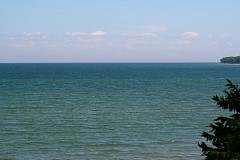
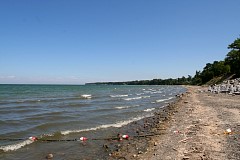
We stopped to see Lake Erie at Lake Erie State Park near Brockton, NY.
Lake Erie is the fourth largest of the Great Lakes in surface area and the smallest by volume.
Lake Erie
is the shallowest of the Great Lakes and is especially vulnerable to fluctuating water levels.
It's the warmest and most biologically productive of the Great Lakes, and
the Lake Erie walleye fishery is widely considered the best in the world.
|
|
The average depth is 62 feet, while the deepest point is 210 feet.
Water spends an average of 2.6 years in the lake - the shortest retention time
of any of the Great Lakes.
The greater part of its southern shore was at one time occupied by a nation known to the Iroquois League as the "Erielhonan," or the "long-tails," a tribe of Indians from which the lake derived its name. This name is always mentioned by the early French writers as meaning "cat". Many attribute this reference to the wild cat or panther.
The Erielhonan were exterminated for aiding the Hurons, the enemy of the Iroquois League.
Both tribes were conquered and exterminated during the Beaver Wars in 1655 by the Iroquois confederacy.
The Iroquois confederacy had firearms obtained from trading with the Dutch, the conquered tribes
had only stone age weapons.
More fish are produced each year for human consumption from Lake Erie than from the other four Great Lakes combined -- Lakes Huron, Michigan Ontario and Superior.
The western end of Lake Erie is the "Walleye Capital of the World," producing more walleye per hectare than any other lake in the world.
During the 1960s and 1970s, Lake Erie experienced changes in water quality associated with increasing levels of the nutrient phosphorus in the water and bottom sediments. The result was eutrophication of the system which resulted in major changes in productivity and algal blooms. The decomposition of algae led to extensive seasonal anoxic areas in the lake (the so-called dead zone), that were expanding rapidly in the early 1970s. The decomposing algal masses and associated fish kills fouled shorelines, contributing to the widespread impression of Lake Erie as a dead lake.
|
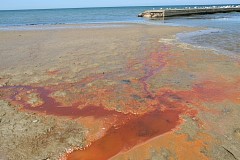
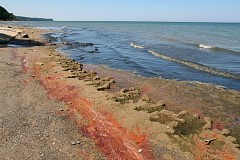
Dead rotting algae smells as bad as it looks.
|
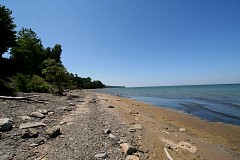
Looking west. The beach isn't sandy but it's still pretty. The park is 355 acres and
has 3/4 of a mile of shoreline. There are high bluffs which provide a great view.
|
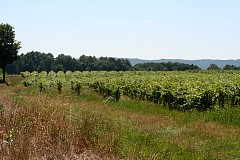
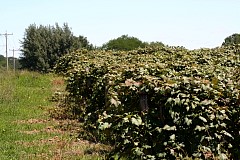
Along the roads leading to and from Lake Erie State Park we kept seeing vineyards.
At one point I pulled over and we got out to look. The eastern shore of Lake Erie is the
heart of the western New York State grape belt.
|


|
|